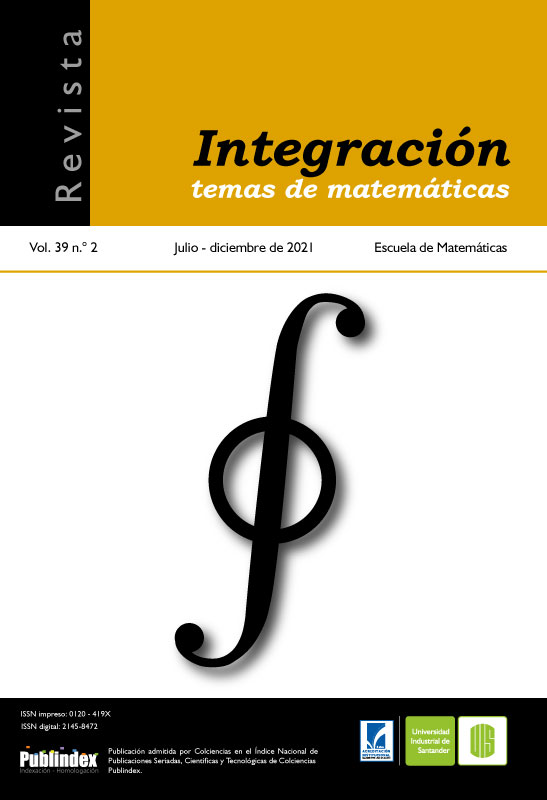Artículos científicos
La aplicación simultanea de intervenciones de control puede llevar a escenarios catastróficos para la población
Publicado 2021-10-07
Palabras clave
- Bifurcación hacia atrás,
- bifurcación hacia adelante,
- bifurcación de Hopf,
- tratamiento,
- aislamiento
Cómo citar
Osuna, O., & Villavicencio Pulido, J. G. (2021). La aplicación simultanea de intervenciones de control puede llevar a escenarios catastróficos para la población. Revista Integración, Temas De matemáticas, 39(2), 177–190. https://doi.org/10.18273/revint.v39n2-2021003
Derechos de autor 2021 Osvaldo Osuna, Jose Geiser Villavicencio Pulido

Esta obra está bajo una licencia internacional Creative Commons Atribución 4.0.
Descargas
Los datos de descargas todavía no están disponibles.
Referencias
- Arino J., McCluskey C.C. and Van den Driessche P., “Global Results for an Epidemic Model with Vaccination that Exhibits Backward Bifurcation”, SIAM J. Appl. Math., 64 (2003), No. 1, 260–276. doi: 10.1137/S0036139902413829.
- Anderson R.M. and May R.M., “Infectious Diseases of Humans: Dynamics and Control”, Oxford university press, 1st ed., vol. 15, New York, 1992.
- Cui J., Mu X. and Wan H., “Saturation recovery leads to multiple endemic equilib ria and backward bifurcation”, J. Theoret. Biol., 254 (2008), No. 2, 275–283. doi: 10.1016/j.jtbi.2008.05.015.
- Dushoff J. Huang W. and Castillo C.C., “Backwards bifurcations and catastrophe in simple models of fatal diseases”, J. Math. Biol., 36 (1998), No. 3, 227–248. doi: 10.1007/s002850050099.
- Eastwood K., Durrheim D.N. and Butler M. and Jon A., “Responses to Pandemic (H1N1) 2009, Australia”, Emerg Infect Dis., 16 (2010), No. 8, 1211–1216. doi: 10.3201/eid1608.100132.
- Feng Z. and Thieme H.R., “Endemic Models with Arbitrarily Distributed Periods of In fection II:Fast Disease Dynamics and Permanent Recovery”, SIAM J. Appl. Math., 61 (2000), No. 3, 983–1012. doi: 10.1137/S0036139998347846.
- Gumel A.B., et. al., “Modelling strategies for controlling SARS outbreaks”, Proceedings of the Royal Society of London. Series B: Biological Sciences., 271 (2004), No. 1554, 2223– 2232. doi: 10.1098/rspb.2004.2800.
- Hadeler K.P. and Castillo C.C., “A core group model for disease transmission”, Math. Biosci., 128 (1995), No. 1, 41–55. doi: 10.1016/0025-5564(94)00066-9.
- Hethcote H. Zhien M. and Shengbing L., “Effects of quarantine in six endemic models for infectious diseases”, Math. Biosci., 180 (2002), No. 1, 141–160. doi: 10.1016/S0025- 5564(02)00111-6.
- Hyman J.M. and Li J., “Modeling the Effectiveness of Isolation Strategies in Pre venting STD Epidemics”, SIAM J. Appl. Math., 58 (1998), No. 3, 912–925. doi: 10.1137/S003613999630561X.
- Jing Z. and Liu Z., “Qualitative analysis for a mathematical model for AIDS”, Acta Math. Appl. Sin., 9 (1993), No. 4, 302–316. doi: 10.1007/BF02005919.
- Kribs C. and Yakubu A.A., “Center manifolds and normal forms in epidemic models”, IMA Vol. Math. Appl., 125 (2002), 269–286.
- Li X. Li W. and Ghosh M., “Stability and bifurcation of an epidemic model with non linear incidence and treatment”, Appl. Math. Comput., 210 (2009), No. 1, 141–150. doi: 10.1016/j.amc.2008.12.085.
- Lancaster P. and Tismenetsky M., The Theory of Matrices: With Applications, Elsevier, 2nd ed., 1985.
- Shen J. and Jing Z., “A new detecting method for conditions of existence of Hopf bifurca tion”, Acta Math. Appl. Sin., 11 (1995), No. 1, 79–93. doi: 10.1007/BF02012625.
- Song B., Du W. and Lou J., “Different Types of Backward Bifurcation due to Density Dependent Treatments”, Math. Biosci. Eng., 10 (2013), No. 5-6, 1651–1668. doi: 10.3934/mbe.2013.10.1651.
- Villavicencio G., Barradas I. and Luna B., “Backward bifurcation for some general recovery functions”, Math. Methods Appl. Sci., 40 (2017), No. 5, 1505–1515. doi: 10.1002/mma.4074.
- Wang J., Liu S., Zheng B. and Takeuchi Y.,“Qualitative and bifurcation analysis using an SIR model with a saturated treatment function”, Math Comput Model., 55 (2012), No. 3-4, 710–722. doi: 10.1016/j.mcm.2011.08.045.
- Wu L. and Feng Z., “Homoclinic bifurcation in an SIQR model for childhood diseases”, J. Differential Equations., 168 (2000), No. 1, 150–167. doi: 10.1006/jdeq.2000.3882.
